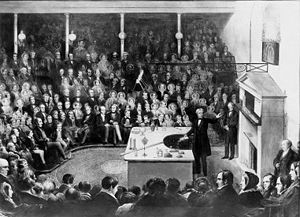Tags
In 1799 The Royal Institution (Ri) was founded by a group of prominent scientists, initially with the goal of bettering the lives of the poor. Its mission focused on the advancement of science and public engagement through frequent lectures. Both still continue to this day. Many famous scientists have been involved with the Ri over the years, including Michael Faraday (1791-1867) who spent most of his working life here. Faraday’s work with electricity made him one of the most influential scientists in history. He inventions included the electromagnetic rotary devices (the precursor to modern electric motors). He coined terms such as cathode, electrode, anode and ion and he discovered benzene.
Over the years 15 Nobel prizes have been awarded to Ri scientists and 10 elements (including Sodium) were discovered here. Needless to say such history and success led to quite a collection of important scientific equipment, papers and experiments.
In 1973 the Ri opened a museum dedicated to Faraday - a place well worth a visit yet generally overlooked. The mission of the Faraday Museum (and the Ri as a whole) is to get people excited about science and scientific discoveries. In the museum Faraday’s original magnetic laboratory and much of his apparatus is on display. The Faraday Museum was refurbished in 2008 and you can now visit the new exhibition “Science in the Making” across the museum’s three floors.
Lower Ground Floor: The majority of the exhibition is located here with a focus on experimentation. On display are the first electrical transformer and actual objects that Ri scientists built and used in some of the world’s most famous experiments. The highlight is Faraday’s magnetic laboratory as it was in the 1850s. Across from this lab is the current state-of-the-art nanotechnology lab.
Ground Floor: The focus is on People where backgrounds on the famous scientists who worked here over the years, including the 15 Nobel Prize winners, are presented.
First Floor: Focus is on Communication with displays showcasing some of the fabulous events that have happened here. Most of the greatest scientists from the last 200 years have presented in their theatre here. A few are remembered through paintings, unusual props and film clips. This is also where the well regarded ‘Christmas Lectures’ take place. The theatre was recently restored and continues to serve its purpose.
Admission to the museum is free. An ‘eGuide’ is availalbe to provide more insight into the stories of the collection (£3 fee). Membership to the Ri is also available for those wanting a deeper, ongoing relationship with this institution. There is also a Restuarant, Bar & Cafe, open at various times throughout the day (not weekends). In addition to visiting the museum, a check of their website for upcoming lectures and events is a way for even the casual observer to learn what is being discovered today in the world of science. See their website for more details: http://www.rigb.org/
Museum Opening Times: 9.00am - 6.00pm Monday to Friday.
Located at: 21 Albemarle Street, Mayfair, W1S 4BS
Closest tube: Green Park


Looks great. I must add it to my list of places to visit! Jut been investigating the South Foreland Lighthouse on the White Cliffs of Dover - where Faraday installed electricity…
Thanks for the comment. I’m not familiar with the lighthouse, so I hope to read about that in one of your posts.